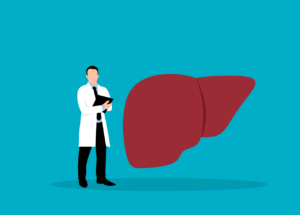Child-Pugh-Turcotte Score Calculator
- Encephalopathy: None = 1 point, Grade 1 and 2 = 2 points, Grade 3 and 4 = 3 points
- Ascites: None = 1 point, slight = 2 points, moderate = 3 points
- Bilirubin: under 2 mg/ml = 1 point, 2 to 3 mg/ml = 2 points, over 3 mg/ml = 3 points
- Albumin: greater than 3.5mg/ml = 1 point, 2.8 to 3.5mg/ml = 2 points, less than 2.8mg/ml = 3 points
- Prothrombin Time* (sec prolonged): less than 4 sec = 1 point, 4 to 6 sec = 2 points, over 6 sec = 3 points
*Frequently INR will be used as a substitute for PT, with INR under 1.7 = 1 point, INR 1.7 to 2.2 = 2 points, INR above 2.2 = 3 points
The severity of cirrhosis:
- Child-Pugh A: 5 to 6 points
- Child-Pugh B: 7 to 9 points
- Child-Pugh C: 10 to 15 points
Definition/Introduction
The Child-Pugh scoring system (also known as the Child-Pugh-Turcotte score) was designed to predict mortality in cirrhosis patients. Originally conceptualized by Child and Turcotte in 1964 to guide the selection of patients who would benefit from elective surgery for portal decompression, it broke down patients into three categories:
A – Good hepatic function
B – Moderately impaired hepatic function
C – Advanced hepatic dysfunction.
Their original scoring system used five clinical and laboratory criteria to categorize patients: serum bilirubin, serum albumin, ascites, neurological disorder, and clinical nutrition status.[1] The scoring system was modified later by Pugh et al., substituting prothrombin time for clinical nutrition status. Additionally, they introduced variable points for each criterion based on increasing severity [2]:
- Encephalopathy: None = 1 point, Grade 1 and 2 = 2 points, Grade 3 and 4 = 3 points
- Ascites: None = 1 point, slight = 2 points, moderate = 3 points
- Bilirubin: under 2 mg/ml = 1 point, 2 to 3 mg/ml = 2 points, over 3 mg/ml = 3 points
- Albumin: greater than 3.5mg/ml = 1 point, 2.8 to 3.5mg/ml = 2 points, less than 2.8mg/ml = 3 points
- Prothrombin Time* (sec prolonged): less than 4 sec = 1 point, 4 to 6 sec = 2 points, over 6 sec = 3 points
*Frequently INR will be used as a substitute for PT, with INR under 1.7 = 1 point, INR 1.7 to 2.2 = 2 points, INR above 2.2 = 3 points
The severity of cirrhosis:
- Child-Pugh A: 5 to 6 points
- Child-Pugh B: 7 to 9 points
- Child-Pugh C: 10 to 15 points
Issues of Concern
Historically the Child-Pugh classification was used for liver transplant allocations. However, there were three primary limitations to its use: 1) grading ascites and encephalopathy require a subjective assessment, 2) the classification system does not account for renal function, and 3) there are only ten different scores (based on points) available. This last limitation was significant because patients were not able to be adequately differentiated based on the severity of the disease, and therefore wait time had a considerable impact on prioritization.[3] Practically speaking, a patient with an INR of 6 and bilirubin of 14 could potentially have the same Child-Pugh score as a patient with an INR of 2.3 and bilirubin of 4.0. The MELD score, which has a broader range of more continuous variable values, was created to account for these differences. The original MELD score calculation used the patient’s bilirubin level, creatinine level, INR, and cause of liver disease.[4] Since then, it has evolved to exclude causes of disease and takes into account the serum sodium level and whether the patient is on dialysis.
Clinical Significance
The Child-Pugh score has been validated as a predictor of postoperative mortality after portocaval shunt surgery and predicts mortality risk associated with other major operations. After abdominal surgery, Child class A patients have a 10% mortality rate; Child class B patients have a 30% mortality rate, and Child class C patients have a 70 to 80% mortality rate[5][6] Child class A patients are generally considered safe candidates for elective surgery. Child class B patients can proceed with surgery after medical optimization but still have increased risk. Elective surgery is contraindicated in Child class C patients. The Child-Pugh score can help predict all-cause mortality risk and development of other complications from liver dysfunction, such as variceal bleeding, as well. In one study, overall mortality for these patients at one year was 0% for Child class A, 20% for Child class B, and 55% for Child class C.[7][8]
References
1.Child CG, Turcotte JG. Surgery and portal hypertension. Major Probl Clin Surg. 1964;1:1-85. [PubMed]
2.Pugh RN, Murray-Lyon IM, Dawson JL, Pietroni MC, Williams R. Transection of the oesophagus for bleeding oesophageal varices. Br J Surg. 1973 Aug;60(8):646-9. [PubMed]
3.Cholongitas E, Burroughs AK. The evolution in the prioritization for liver transplantation. Ann Gastroenterol. 2012;25(1):6-13. [PMC free article] [PubMed]
4.Malinchoc M, Kamath PS, Gordon FD, Peine CJ, Rank J, ter Borg PC. A model to predict poor survival in patients undergoing transjugular intrahepatic portosystemic shunts. Hepatology. 2000 Apr;31(4):864-71. [PubMed]
5.Mansour A, Watson W, Shayani V, Pickleman J. Abdominal operations in patients with cirrhosis: still a major surgical challenge. Surgery. 1997 Oct;122(4):730-5; discussion 735-6. [PubMed]
6.Garrison RN, Cryer HM, Howard DA, Polk HC. Clarification of risk factors for abdominal operations in patients with hepatic cirrhosis. Ann Surg. 1984 Jun;199(6):648-55. [PMC free article] [PubMed]
7.Infante-Rivard C, Esnaola S, Villeneuve JP. Clinical and statistical validity of conventional prognostic factors in predicting short-term survival among cirrhotics. Hepatology. 1987 Jul-Aug;7(4):660-4. [PubMed]
8. Andrea Tsoris; Clinton A. Marlar. Use Of The Child Pugh Score In Liver Disease. In: StatPearls [Internet]. Treasure Island (FL): StatPearls Publishing; 2022 Jan.2021 Mar 22. [PubMed]
Source: StatPearls Publishing LLC.[PubMed]
Disclaimer: The information provided on this website is for informational purposes only and is not intended to take the place of consultation with your physician.
